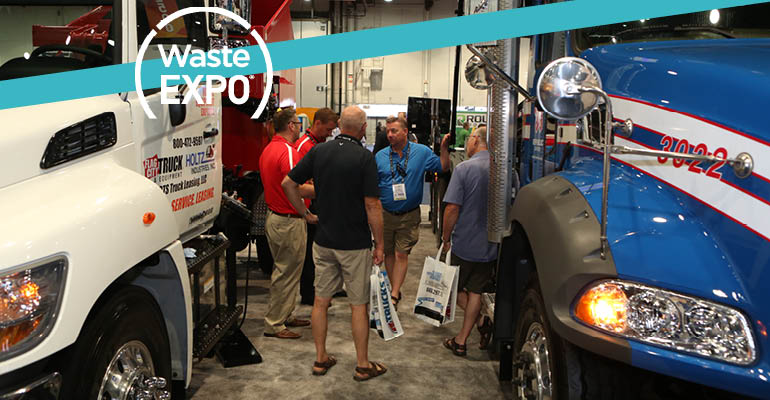The second full day of activities at WasteExpo came with plenty of insights and highlights.

WasteExpo 2017’s second day included events recognizing the National Waste & Recycling Association’s annual award winners and Waste360’s second 40 Under 40 class. It also included dozens of more sessions as part of WasteExpo’s education program and the first day of activity at the Exhibit Hall.
Here are some key takeaways from the second day of WasteExpo:
Kevin Kraushaar of the NWRA, Rich Goodstein of Goodstein & Associates and Ashley Davis of Republic Services/West Front Strategies discussed how the Trump administration will affect the waste and recycling industry during their session.
Kraushaar stated that 2017 started off very chaotically, which caused industry members to scramble to make their case to Congress regarding many issues. He also said that the minus of working with the new administration is that it’s “government by Twitter.” As the year goes on, he advises members of the industry to not ignore the basics and to keep an eye on the administration’s Twitter feeds.
Davis, who spoke from a Republican perspective, said that there won’t be a 31 percent cut to the Environmental Protection Agency’s (EPA) budget because the Congress would never cut a budget of that amount. She also stated that the health care plan process was brutal and made everyone look like amateurs, and if the tax rate lowers, the administration will cut a lot of incentives that are important to the industry, such as tax credits.
Goodstein, who spoke from a Democratic perspective, said that regulations that we don’t like can’t just be undone with a snap of a finger. In addition, he stated that the EPA will focus on reversing regulations like the Clean Power Plan and Waters of the United States, and democrats will continue to be leery until President Donald Trump releases his tax returns, which will never happen. He also advised industry members to watch what President Trump does and not what he says because he’s all over the map.
During the “Lessons in Bio-Waste, Organics Diversion and Food Waste Recovery: Policies and Programs in the EU and Australia” session, Herman Huisman and Martin Van Nieuwenhoven of the International Cooperation, the Netherlands, and Rachel Ajayi of the Centre for Environment and Population Health, Griffith University in Australia, explained what’s working and what’s not working when it comes to food waste policies in the European Union and Australia.
Van Nieuwenhoven stated that very little is happening in Europe on the production level and that a lot of good, edible food in households is being thrown away because of packaging label dates. He then explained the five key areas of EU’s circular economy plan: plastics, food waste critical raw materials, construction and demolition and biomass and bio-based products. In addition, he revealed that between 2009 and 2014, there was no reduction of food waste in the Netherlands. But now, small and large companies in the Netherlands are showing good results in combating food waste.
Huisman shared an assessment of EU food waste policy:
The latest EU proposals for dealing with food waste and the creation of a platform are insufficient for combating food waste effectively.
EU policies have the potential to combat food waste, but their potential is not being exploited.
EU action is fragmented and coordination at the European Commission level is lacking.
No agreed baseline from which to target reductions.
The commission should strengthen the EU strategy to combat food waste and coordinate it better, with an action plan for the years ahead and a clear definition of food waste.
The commission should consider food waste in future impact assessments.
The commission should identify and resolve legal obstacles to food donation, encourage the further use of existing donation possibilities and consider how to encourage donation in other policy areas.
Ajayl said that Australia doesn’t have specific policies on food waste, but it’s slowing moving forward with that. She also shared what works for food waste diversion, such as KISS (keep it simple and short) the three Cs (consistency, collaboration and clarity), branding, affordability, door-to-door awareness campaigns and strong leadership. And what doesn’t work, such as ambiguity, optional participation, complex processes, inconsistency, high costs and weak leadership.
At the “MRF Innovations” session, Ken Beaver of Environmental Solutions, Tim Horkay of Penn Waste and David Hudson of Recology explained the latest developments in MRF technology, including burgeoning developments with robotics.
Beaver said the industry is at the same place with organics than it was with recycling 30 years ago. He also shared that about 57 percent of what’s in the average waste bin is a form of organics, and that tip fee (avoidance) is a primary driver of economical organics diversion. He also explained the benefits of a blue bag/green bag system. With Waste Robotics, citizens now put their organics into a green bag and place that green bag into their existing garbage cart. Then, a garage truck brings the collected material to an intelligent transfer station or material recovery facility (MRF), where Waste Robotics extracts the green organics bags from the waste stream. With this process, clean organics are diverted from landfills and can go toward composting or anaerobic digestion.
Hudson touched on Recology’s upgrades, which includes a drum feeding system with direct feed bypass, a 14-person sort line with a film collection system, larger cardboard and mixed-paper screens, two glass cleaning systems, two additional optical sorting machines, a residue paper/plastic recovery system and a fully integrated monitoring and control system. Since the updates, Recology has seen more materials captured on the first pass, one to two additional loads of mixed paper generated daily, the ability to run 45+ tph with the capacity to ramp higher during peak seasons, recovery consistently over 90 percent, reduced labor and overtime expenses, improved quality of fiber, plastics and glass, new materials captured and a cleaner operation.
Horkay spoke about Penn Waste’s retrofit, which will take place this June. The company chose to consider a retrofit because of rising labor costs, the shifting ton, new quality initiatives and the option to remove barriers for additional tonnage. In June, Penn Waste will retrofit the container line, add 10 tph of capacity to its MRF, reduce labor and stop diversion during installation.
The National Waste & Recycling Association (NWRA) had revealed the winners of its annual awards in late March. The winners were honored at the the annual awards breakfast. Among the highlights was Rhonda Kitchen, from the Wasatch Front Waste and Recycling District, Midvale, Utah, becoming the first woman ever recognized as a Driver of the Year. Nine other drivers from across the country were also recognized. Bruce Russin of Casella Waste Solutions was recognized as Operator of the Year.
Charlie Latham with Waste Management received the Chapter Leadership Award. Meanwhile, Carmen Smothers, Environmental Solutions Group, James Thaxton, Rumpke Waste & Recycling, Robert Pfister, Advanced Disposal and Carl Hornberger, Republic Services, received Distinguished Service Awards. And Michael McLaughlin, Scranton Manufacturing Company and Garrett Trierweiler, Waste Management received NWRA Member of the Year awards.
Ronald Mittelstaedt, Waste Connections Inc., John and Douglas Casella, Casella Waste Services Inc. and Kenneth Burkett, American Waste Control Inc., were inducted in the NWRA Hall of Fame.
A select number of industry members got to experience a zero waste lunch made from salvaged food on Tuesday. The lunch, which was created in partnership with Centerplate (New Orleans Morial Convention Center’s foodservice provider), GES, New Orleans Morial Convention Center, Salvage Supperclub, The Green Project and The Composting Network, took place inside a rented dumpster equipped with salvaged wood seats and flooring and rescued doors for a table, all of which came from local companies.
Here’s a rundown of the menu and the dishes’ salvage stories:
Beet Salad - Mixed greens, goat cheese, candied pecan bits and beet puree with champagne vinaigrette. Pureed beet scraps, trimmed tops and bottoms were turned into confit. Pecan bits that would otherwise be disposed of topped the salad. Remaining champagne from Centerplate’s bars department was combined with white vinegar to create the dressing.
Abita Amber BBQ Shrimp – Pan-seared gulf shrimp and yellow stone-ground grits topped with grilled peppers and onions. Shrimp shells were ground down and used for stock with remaining Abita Amber Beer product, which were combined and used as the sauce. The grits were a combination of remaining yellow stone-ground grits and pureed cauliflower curd and stems (otherwise tossed pieces).
Bananas Foster Bread Pudding - French bread, bananas and yumm rum sauce. French bread (otherwise considered stale) was used for the bread pudding, and salvaged bananas that would otherwise be considered “too old” to sell/display was caramelized and added to the dish. The sauce was made from the rum leftover from Centerplate’s bar inventory.
The Waste360 40 Under 40 Awards reception took place on Tuesday afternoon. The 2017 award recipients were joined by friends, family, coworkers and the Waste360 staff to accept their awards and celebrate their significant impact on the waste, recycling and organics industry.
About the Author(s)
You May Also Like






